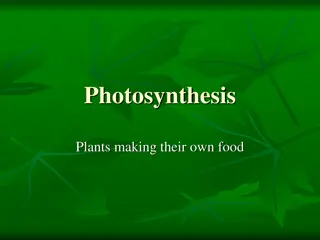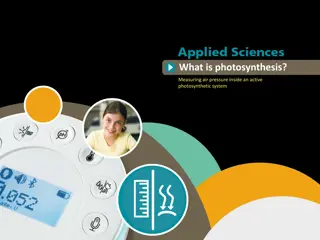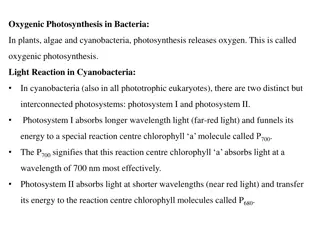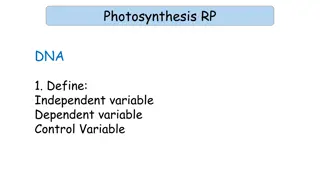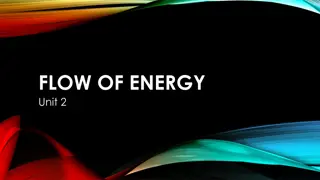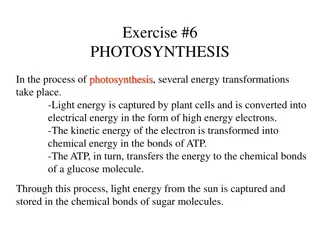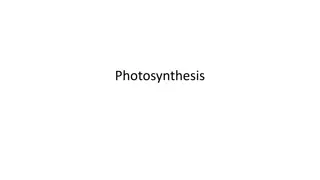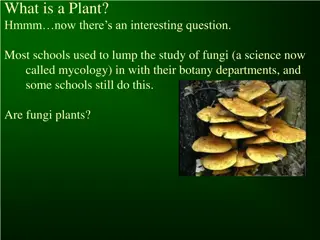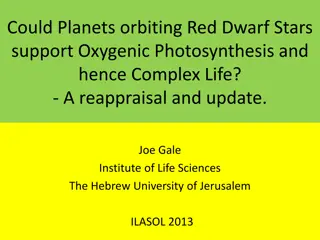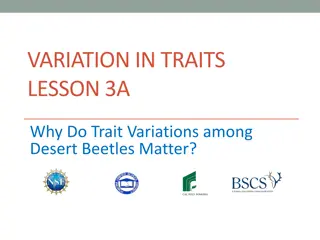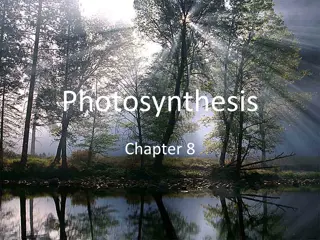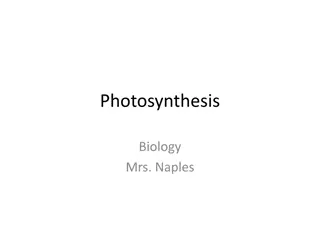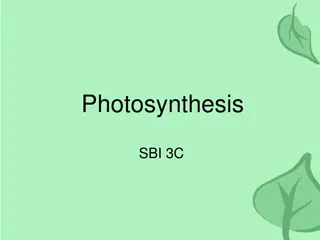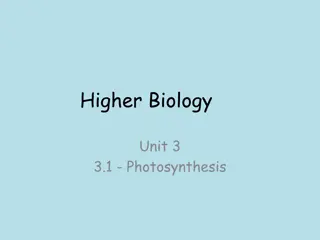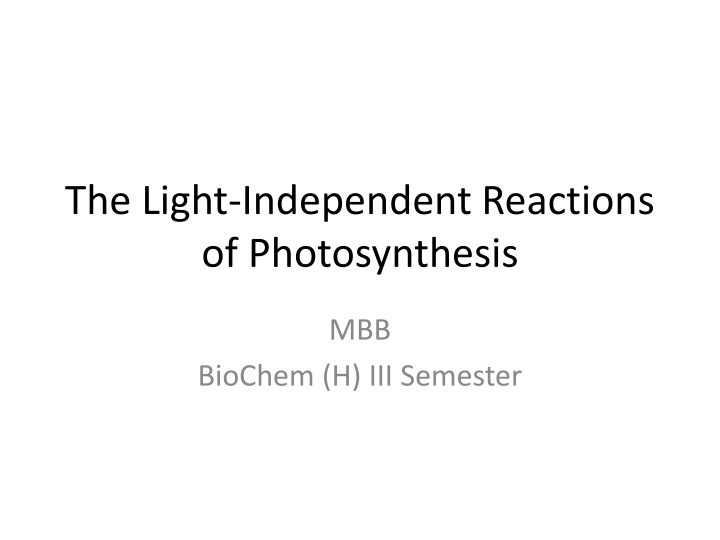
Evolution of Photosynthesis in Desert Plants
Desert plants have evolved unique adaptations to conserve water and thrive in harsh conditions. Through mechanisms like CAM and C4 photosynthesis, these plants efficiently utilize CO2 and minimize water loss, allowing them to survive in arid environments. This evolution enables desert plants to make the most of every drop of water to sustain life, showcasing nature's incredible resilience and ingenuity.
Download Presentation

Please find below an Image/Link to download the presentation.
The content on the website is provided AS IS for your information and personal use only. It may not be sold, licensed, or shared on other websites without obtaining consent from the author. If you encounter any issues during the download, it is possible that the publisher has removed the file from their server.
You are allowed to download the files provided on this website for personal or commercial use, subject to the condition that they are used lawfully. All files are the property of their respective owners.
The content on the website is provided AS IS for your information and personal use only. It may not be sold, licensed, or shared on other websites without obtaining consent from the author.
E N D
Presentation Transcript
The Light-Independent Reactions of Photosynthesis MBB BioChem (H) III Semester
Some plants have evolved mechanisms to increase the CO2concentration in their leaves under hot and dry conditions. CAM AND C4 PHOTOSYNTHESIS
Key Points The process of photosynthesis in desert plants has evolved mechanisms to conserve water. Plants that use crassulacean acid metabolism (CAM) photosynthesis fix CO2at night, when their stomata are open. Plants that use C4 carbon fixation concentrate carbon dioxide spatially, using bundle sheath cells which are inundated with CO2.
Key Terms crassulacean acid metabolism: A carbon fixation pathway that evolved in some plants as an adaptation to arid conditions, in which the stomata in the leaves remain shut during the day to reduce evapotranspiration, but open at night to collect carbon dioxide (CO2). C4 carbon fixation: A form of photosynthesis in which plants concentrate CO2 spatially, with a RuBisCO reaction centre in a bundle sheath cell that is inundated with CO2
Photosynthesis in desert plants has evolved adaptations that conserve water. In harsh, dry heat, every drop of water must be used to survive. Because stomata must open to allow for the uptake of CO2, water escapes from the leaf during active photosynthesis.
Desert plants have evolved processes to conserve water and deal with harsh conditions. A more efficient use of CO2allows plants to adapt to living with less water.
Some plants such as cacti can prepare materials for photosynthesis during the night by a temporary carbon fixation and storage process, because opening the stomata at this time conserves water due to cooler temperatures. In addition, cacti have evolved the ability to carry out low levels of photosynthesis without opening stomata at all, a mechanism for surviving extremely dry periods.
CAM Photosynthesis Xerophytes, such as cacti and most succulents, also use phosphoenolpyruvate (PEP) carboxylase to capture carbon dioxide in a process called crassulacean acid metabolism (CAM). In contrast to C4metabolism, which physically separates the CO2fixation to PEP from the Calvin cycle, CAM temporally separates these two processes.
CAM plants have a different leaf anatomy from C3 plants, and fix the CO2 at night, when their stomata are open. CAM plants store the CO2 mostly in the form of malic acid via carboxylation of phosphoenolpyruvate to oxaloacetate, which is then reduced to malate. Decarboxylation of malate during the day releases CO2 inside the leaves, thus allowing carbon fixation to 3-phosphoglycerate by RuBisCO. Sixteen thousand species of plants use CAM.
C4 Carbon Fixation The C4 pathway bears resemblance to CAM; both act to concentrate CO2around RuBisCO, thereby increasing its efficiency. CAM concentrates it temporally, providing CO2during the day and not at night, when respiration is the dominant reaction.
C4 plants, in contrast, concentrate CO2 spatially, with a RuBisCO reaction centre in a bundle sheath cell that is inundated with CO2. Due to the inactivity required by the CAM mechanism, C4 carbon fixation has a greater efficiency in terms of PGA synthesis.
C4 plants can produce more sugar than C3 plants in conditions of high light and temperature. Many important crop plants are C4 plants, including maize, sorghum, sugarcane, and millet. Plants that do not use PEP-carboxylase in carbon fixation are called C3 plants because the primary carboxylation reaction, catalyzed by RuBisCO, produces the three-carbon 3-phosphoglyceric acids directly in the Calvin-Benson cycle.
Over 90% of plants use C3 carbon fixation, compared to 3% that use C4 carbon fixation; however, the evolution of C4 in over 60 plant lineages makes it a striking example of convergent evolution.
The Calvin cycle is organized into three basic stages: fixation, reduction, and regeneration. THE CALVIN CYCLE
In plants, carbon dioxide (CO2) enters the leaves through stomata, where it diffuses over short distances through intercellular spaces until it reaches the mesophyll cells. Once in the mesophyll cells, CO2diffuses into the stroma of the chloroplast, the site of light- independent reactions of photosynthesis.
These reactions actually have several names associated with them. Other names for light- independent reactions include the Calvin cycle, the Calvin-Benson cycle, and dark reactions. The most outdated name is dark reactions, which can be misleading because it implies incorrectly that the reaction only occurs at night or is independent of light, which is why most scientists and instructors no longer use it.
Light-dependent reactions harness energy from the sun to produce chemical bonds, ATP, and NADPH. These energy-carrying molecules are made in the stroma where the Calvin cycle takes place. The Calvin cycle is not totally independent of light since it relies on ATP and NADH, which are products of the light-dependent reactions.
The light-independent reactions of the Calvin cycle can be organized into three basic stages: fixation, reduction, and regeneration.
Stage 1: Fixation In the stroma, in addition to CO2,two other components are present to initiate the light- independent reactions: an enzyme called ribulose bisphosphate carboxylase (RuBisCO) and three molecules of ribulose bisphosphate (RuBP). RuBP has five atoms of carbon, flanked by two phosphates. RuBisCO catalyzes a reaction between CO2and RuBP.
For each CO2molecule that reacts with one RuBP, two molecules of 3-phosphoglyceric acid (3-PGA) form. 3-PGA has three carbons and one phosphate. Each turn of the cycle involves only one RuBP and one carbon dioxide and forms two molecules of 3-PGA.
The number of carbon atoms remains the same, as the atoms move to form new bonds during the reactions (3 atoms from 3CO2+ 15 atoms from 3RuBP = 18 atoms in 3 atoms of 3- PGA). This process is called carbon fixation because CO2is fixed from an inorganic form into organic molecules.
Stage 2: Reduction ATP and NADPH are used to convert the six molecules of 3-PGA into six molecules of a chemical called glyceraldehyde 3-phosphate (G3P). This is a reduction reaction because it involves the gain of electrons by 3-PGA. Recall that a reduction is the gain of an electron by an atom or molecule.
Six molecules of both ATP and NADPH are used. For ATP, energy is released with the loss of the terminal phosphate atom, converting it to ADP; for NADPH, both energy and a hydrogen atom are lost, converting it into NADP+. Both of these molecules return to the nearby light-dependent reactions to be reused and reenergized.
Stage 3: Regeneration At this point, only one of the G3P molecules leaves the Calvin cycle and is sent to the cytoplasm to contribute to the formation of other compounds needed by the plant. Because the G3P exported from the chloroplast has three carbon atoms, it takes three turns of the Calvin cycle to fix enough net carbon to export one G3P.
But each turn makes two G3Ps, thus three turns make six G3Ps. One is exported while the remaining five G3P molecules remain in the cycle and are used to regenerate RuBP, which enables the system to prepare for more CO2to be fixed. Three more molecules of ATP are used in these regeneration reactions.




